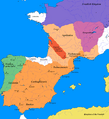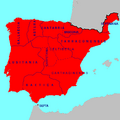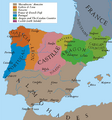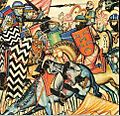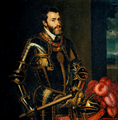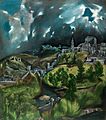History of Spain facts for kids
Spain is a country in Europe. It's a land with a long and exciting history, from ancient times to today.
Contents
Ancient History of Spain
People have lived in the area that is now Spain for a very long time, about 500,000 years! Neanderthal people arrived around 200,000 years ago, and modern humans came about 40,000 years ago.
Thousands of years ago, groups like the Iberians and Celts lived here. The Phoenicians, who were great traders, also built some cities to get valuable tin and silver.
Roman Rule and Visigoths
The powerful Roman Empire took control of Spain for about 300 years. After the Romans, people from Eastern Europe called the Visigoths fought and won control of Spain. They ruled for over 200 years.
This period, when Germanic tribes like the Visigoths and Suebi took over after the Romans, marked the start of the Middle Ages in Spain.
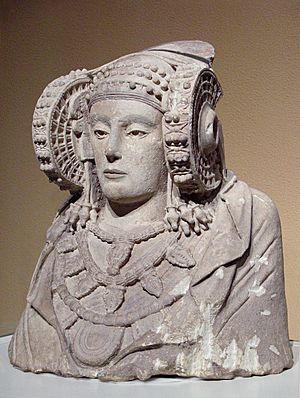
Medieval Spain: Muslims and Christians
In the year 711, a new era began when Muslim armies arrived from North Africa. They conquered much of the Iberian Peninsula, bringing the religion of Islam with them. This region became known as Al-Andalus and was a center of learning and culture for many centuries during the Islamic Golden Age.
The only part of Spain that remained Christian was a small area in the north called the Kingdom of Asturias.
The Reconquista
Over time, Christian kingdoms in Europe decided to fight to take Spain back from the Muslims. These wars lasted for almost 800 years and are known as the Reconquista. It was a long and sometimes harsh period of conflict.
As the centuries passed, Christian kingdoms in the north slowly grew stronger and expanded their control. Important kingdoms like the Kingdom of Navarre, the Kingdom of León, the Kingdom of Castile, and the Kingdom of Aragon were formed. These kingdoms eventually joined together to become two main powers: the Crown of Castile and the Crown of Aragon.
Meanwhile, in the southwest, the Kingdom of Portugal developed its own unique identity.
Spain in the Late 1400s
A very important year for Spain was 1492. In this year, the Christian rulers took the last Muslim kingdom in Spain, Granada. Boabdil, the last Muslim leader of Granada, gave the city to King Ferdinand II of Aragon on January 2, 1492. This meant that Christians now ruled all of Spain.
Before this, the kingdoms of Castile and Aragon had united when King Ferdinand II of Aragon married Queen Isabella of Castile.
Columbus and the New World
In that same year, 1492, King Ferdinand and Queen Isabella decided to support Christopher Columbus on his journey across the Atlantic Ocean. Columbus found lands that Europeans didn't know about yet, which were the islands of the Caribbean Sea.
Columbus and other explorers soon discovered two huge continents: North America and South America. Spain sent many soldiers and explorers to these new lands, taking control of large parts of them. This new empire made Spain very rich, especially from the gold and silver found there. However, this conquest also led to the deaths of millions of Native Americans who already lived there. Spain controlled this vast empire for over 300 years.
At home in Spain, the multicultural society that had existed for centuries changed. Many Muslim books were destroyed, and Jewish people were forced to leave Spain. This led to a loss of much learning and diversity. However, some things, like certain types of music and beautiful buildings, were kept and valued. Many Muslim buildings were even turned into churches.
Spain's Golden Age: 16th and 17th Centuries
For much of the 16th and 17th centuries, the Spanish Empire was the most powerful in the world. This was largely due to the huge amounts of gold and silver flowing in from the Americas. This wealth made the rulers and colonial governors very rich.
However, this new wealth also caused problems. Prices went up (called inflation), making life harder for ordinary people. Spain became a society with a few very rich people and many very poor people. Some of the poorest people traveled to the new colonies in the Caribbean, Central America, and South America, hoping to find gold themselves.
Impact on Native Americans
Sadly, millions of Native American people died from diseases brought by the Spanish explorers. The Spanish often found societies that were already struggling, and they used this as an excuse to enslave the native people. Many natives died working in the gold mines for the Spanish.
The Spanish Inquisition
During this time, the Spanish Empire also supported the Spanish Inquisition. This was a powerful religious court that punished and sometimes killed anyone who disagreed with the Catholic Church. The Protestant Reformation, which led to new Christian groups in Europe, was not allowed in Spain. People who believed differently, like Protestants, Jews, or Muslims, were often persecuted.
The powerful noble families in Spain no longer had to fight each other, and no one could easily challenge their power. People who disagreed with them were often called "heretics" so the Inquisition could punish them, and the nobles could take their property.
For ordinary people, both in Spain and in the Americas, life often became harder. While a few rulers became incredibly wealthy, many people suffered greatly.
It was during this period that the famous book Don Quixote, a great satire, was written.
18th Century Challenges
In the 18th century, there was a big argument over who should be the next king of Spain. This led to a major conflict called the War of the Spanish Succession, where many European kings fought to claim the Spanish throne.
Later, France occupied Spain for a long time, which made Spain much weaker. This also led to Spain losing most of its empire in North and South America. Many parts of the empire became independent countries, or were taken over by other nations like the United States.
Spain in the 20th Century
The first part of the 20th century was not peaceful for Spain. Some people in Spain wanted to create a government chosen by the people, a democracy. They even made the King of Spain leave the country.
However, in 1936, two different groups of Spaniards went to war. One group wanted democracy, and the other wanted a single person to rule. This terrible conflict was the Spanish Civil War. In 1939, those who wanted democracy were defeated, and a dictator named Francisco Franco took control of the government.
Franco ruled Spain until he died in 1975. Before he died, he decided that Spain should have a king again, and he chose Juan Carlos I, the grandson of the king who had left the country. But King Juan Carlos did not rule as a dictator. Instead, he chose to set up a democracy. After Franco's death, Adolfo Suárez became Spain's first democratically elected prime minister.
Today, Spain is a modern democratic country. It does business with many countries around the world and is an important part of the European Union.
Images for kids
-
An illustration of the (now lost) Luzaga's Bronze, an example of ancient Celtiberian writing.
-
The Roman Empire in the 3rd century.
-
The greatest size of the Visigothic Kingdom around 500 AD.
-
Visigothic King Roderic speaking to his soldiers before the Battle of Guadalete.
-
A detail of the crown of Recceswinth from the Treasure of Guarrazar.
-
Visigothic Spain and its regions in 700 AD, before the Muslim conquest.
-
The Christian kingdoms and the Islamic Almohad empire around 1210.
-
A battle from the Reconquista, shown in the Cantigas de Santa Maria.
-
The taking of Oran by Francisco Jiménez de Cisneros in 1509.
-
The Port of Seville in the late 16th century. Seville became a very important city after the discoveries in the New World.
-
Charles I of Spain, one of the most powerful European rulers of his time.
-
A map of Europe in 1648, after the Peace of Westphalia.
-
View of Toledo by El Greco, painted between 1596 and 1600.
-
Louis XIV of France and Philip IV of Spain meeting in 1660 to end the Franco-Spanish War.
-
An 18th-century map of the Iberian Peninsula.
-
The Second of May 1808 marked the start of Spanish resistance against Napoleon.
-
The promulgation of the Constitution of 1812, an oil painting by Salvador Viniegra.
-
An event from the Spanish Revolution of 1854 in Madrid's Puerta del Sol.
-
The explosion of the USS Maine led to the Spanish–American War in April 1898.
-
The successful Alhucemas landing in 1925 helped Spain in the Rif War.
-
The ruins of Guernica after bombing.
-
Francisco Franco and his chosen successor, Prince Juan Carlos de Borbón.
-
Felipe González signing the treaty for Spain to join the European Economic Community in 1985.
See also
 In Spanish: Historia de España para niños
In Spanish: Historia de España para niños





